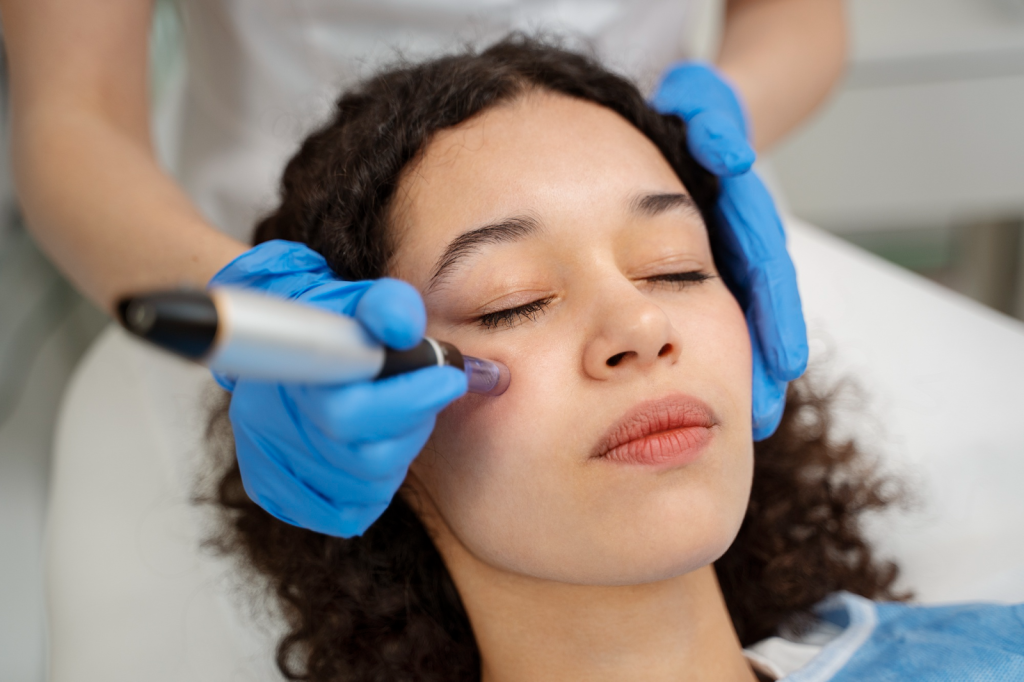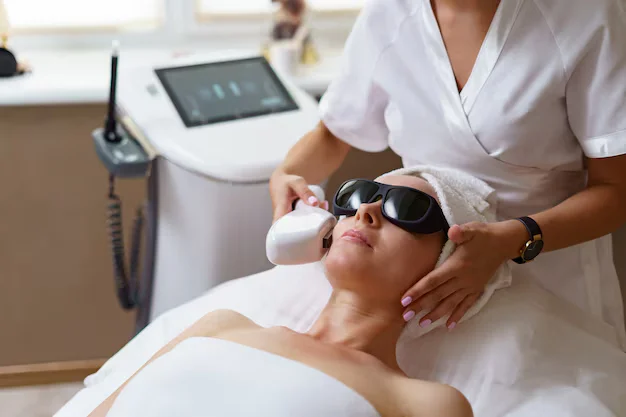Pigmentation disorders, especially in individuals with melanin-rich skin, have long posed a challenge in aesthetic dermatology for Pico Laser Breaks Down Pigmentation. However, the advent of picosecond laser technology has brought a revolutionary solution. This advanced technology offers unparalleled precision in targeting unwanted pigment, while significantly reducing thermal damage to surrounding tissues, a feat that traditional laser treatments struggle to achieve.
Understanding the unique mechanism behind picosecond lasers is crucial for patients seeking safe and effective solutions for pigmentation. Pigmentation treatment using a Pico Laser utilises ultra-short pulse durations, measured in picoseconds, to achieve photoacoustic fragmentation of pigment particles, which is fundamentally different from the thermal mechanisms employed by traditional laser systems.
Understanding Picosecond Pulse Technology
Picosecond lasers operate on pulse durations measured in trillionths of a second, representing a significant advancement over nanosecond Q-switched lasers that preceded them. According to research published in PMC, the mechanism of tissue breakdown induced by picosecond laser relies on free electrons, generated by either thermionic emission or chromophore-independent multiphoton absorption, with the electron density reaching critical levels that cause photoacoustic disruption.
The ultra-short pulse duration prevents heat accumulation in surrounding tissues, fundamentally changing how laser energy interacts with pigmented structures. Instead of thermal ablation, picosecond lasers create rapid pressure waves that mechanically fragment pigment particles into smaller pieces, allowing the body’s natural clearance mechanisms to eliminate them more efficiently.
This photoacoustic mechanism enables precise targeting of pigmented lesions while minimising collateral thermal damage to adjacent healthy tissues. The reduced thermal effect significantly decreases the risk of post-inflammatory hyperpigmentation, making picosecond technology particularly suitable for treating pigmentation in darker skin types for Pico Laser Breaks Down Pigmentation.
Step into the spotlight—read our related post that’s trending among readers!
Photoacoustic Fragmentation vs. Thermal Ablation
Traditional laser systems rely primarily on thermal mechanisms to destroy pigmented targets, generating heat that can damage surrounding tissues and trigger inflammatory responses. Research published in multiple PubMed studies demonstrates that picosecond lasers achieve pigment clearance through photoacoustic disruption rather than thermal destruction.
According to the photoacoustic effect principle, when ultra-short pulses encounter pigment particles, they generate rapid thermal expansion and contraction cycles, creating acoustic shock waves. These mechanical forces fragment pigmented structures into smaller particles without the sustained heat generation associated with longer pulse durations.
The fragmentation process breaks pigment deposits into particles small enough for enhanced lymphatic clearance, typically reducing particle size from micrometres to nanometers. This improved clearance mechanism contributes to more complete pigment removal with fewer treatment sessions compared to traditional thermal-based systems.
Clinical Evidence for Asian Skin Safety
Extensive clinical research has unequivocally demonstrated the safety and efficacy of picosecond lasers for treating pigmentation in Asian patients. A prospective study published in PubMed, which examined 755-nm picosecond laser treatment, found that the technology is not only safe but also highly effective for treating melasma in individuals with dark skin. Importantly, it reported no additional benefit from diffractive lens arrays compared to standard flat optics, further solidifying the technology’s safety and efficacy.
Another significant study, published in PubMed, evaluated fractional 1064 nm picosecond laser treatment in Asian patients and found that the technology was effective in treating melasma and promoting skin rejuvenation, while being safe and well-tolerated. Importantly, the research reported no hypo or hyperpigmentation complications, addressing the primary concern for darker skin types.
A systematic review published in Frontiers, comparing picosecond Nd:YAG laser, picosecond alexandrite laser, and hydroquinone cream, found that picosecond lasers demonstrated effectiveness and safety for melasma treatment, contributing to the growing evidence base supporting this technology for Asian skin applications.
Wavelength Selection and Pigment Targeting
Picosecond lasers utilise specific wavelengths optimised for different types of pigmentation, with 755 nm alexandrite and 1064 nm Nd:YAG representing the most commonly employed wavelengths. The wavelength selection depends on the target chromophore and depth of pigmentation being treated.
The 755 nm wavelength demonstrates strong absorption by melanin, making it particularly effective for superficial pigmented lesions, including freckles, age spots, and superficial melasma. Research published in PMC has demonstrated the significant efficacy of 755 nm picosecond lasers in treating various pigmented lesions in Asian patients.
The 1064 nm wavelength penetrates deeper into tissues with less melanin absorption, making it suitable for treating deeper pigmentation and reducing the risk of epidermal damage in darker skin types. Clinical studies have demonstrated the safety and efficacy of 1064 nm picosecond lasers for treating melasma and post-inflammatory hyperpigmentation in Asian populations.
Minimal Downtime and Recovery

One of the significant advantages of picosecond laser technology lies in its minimal downtime profile compared to traditional ablative procedures. The photoacoustic mechanism preserves the skin’s surface integrity while targeting pigmented structures at various depths, eliminating the need for extended recovery periods and ensuring patient comfort.
Most patients experience only mild erythema and slight swelling immediately following treatment, with these effects typically resolving within 24-48 hours. The absence of significant thermal damage allows patients to resume normal activities immediately, with only basic sun protection requirements during the healing process.
The reduced inflammation and faster healing times make picosecond lasers particularly appealing for working professionals and individuals who cannot accommodate extended recovery periods. This practical advantage, combined with improved safety profiles, has contributed to increased patient acceptance of laser pigmentation treatments.
Treatment Applications and Efficacy
Picosecond lasers demonstrate versatility in treating various types of pigmentation disorders commonly seen in Asian populations. Clinical research has established the remarkable efficacy for melasma, post-inflammatory hyperpigmentation, solar lentigines, and café-au-lait macules, instilling optimism about its potential.
Melasma Treatment
Research published in PubMed examining the treatment of refractory melasma with a picosecond alexandrite laser demonstrated significant improvements in Asian patients. Multiple studies confirm that picosecond technology can effectively address melasma while minimising the risk of paradoxical darkening that sometimes occurs with traditional laser treatments.
Post-Inflammatory Hyperpigmentation
Studies published in PMC demonstrate that picosecond lasers effectively treat post-inflammatory hyperpigmentation resulting from acne, trauma, or previous treatments. The reduced thermal effect minimises the risk of creating additional inflammation that could worsen existing pigmentation.
Age Spots and Solar Lentigines
Research published in PMC evaluating the efficacy of a 755 nm picosecond laser found significant clearance of pigmented lesions after single treatments, with photographic analysis confirming measurable improvements in various types of solar-induced pigmentation.
Treatment Protocol and Expectations
Picosecond laser treatments or Pico Laser Breaks Down Pigmentation typically require multiple sessions spaced 4-6 weeks apart to achieve optimal results. The number of sessions varies based on the type, depth, and extent of pigmentation being treated, with most patients requiring 3-6 treatments for significant improvement.
Treatment protocols are individualised based on skin type, pigmentation characteristics, and patient tolerance. Asian patients often require modified parameters to optimise efficacy while maintaining safety margins appropriate for melanin-rich skin.
Progressive improvement becomes apparent over the weeks following each treatment as fragmented pigment particles are eliminated through natural cellular processes. The gradual improvement timeline allows for natural-appearing results without the dramatic changes associated with more aggressive treatments.
Understanding picosecond laser technology provides valuable insight into modern pigmentation treatment options that prioritise both efficacy and safety. The combination of photoacoustic fragmentation, minimal thermal damage, and established safety profiles for Asian skin makes Pico Laser an advanced option for patients seeking comprehensive pigmentation solutions without compromising skin integrity or requiring extended recovery periods.
Don’t miss our featured posts—where ideas shine and inspiration comes alive!







